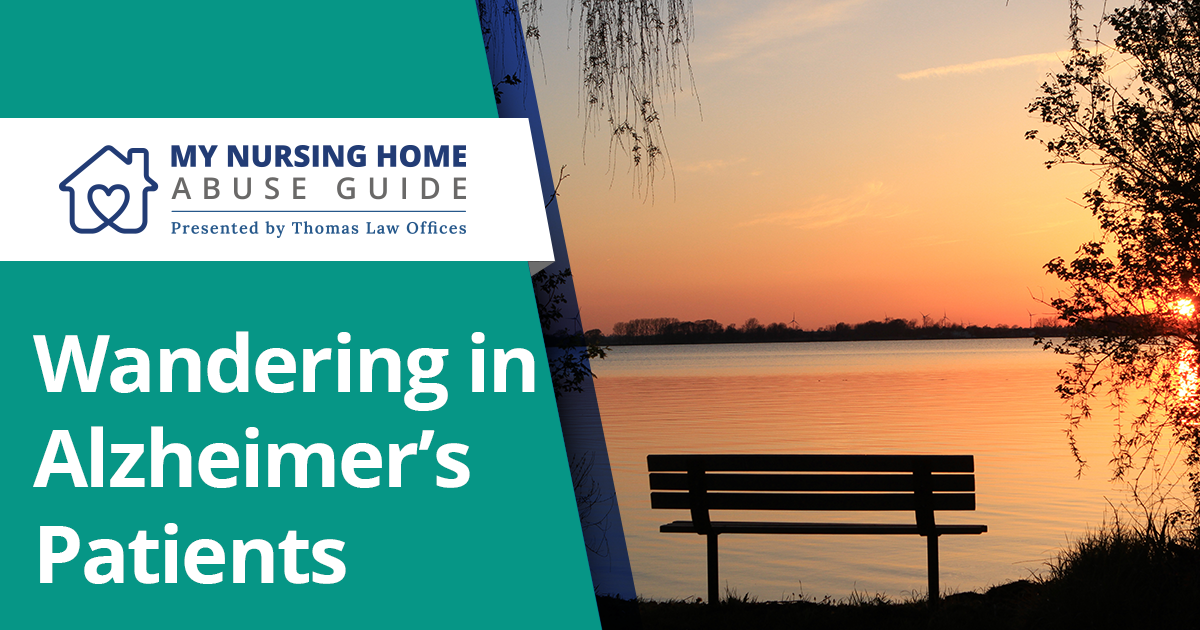Your Guide to Nursing Home Abuse & Prevention
Millions of elderly adults live in nursing home facilities.
Every one of them deserves to feel safe, protected, and respected.
Millions of elderly adults live in nursing home facilities.
Every one of them deserves to feel safe, protected, and respected.

Wandering is a common and potentially dangerous behavior among individuals with Alzheimer’s disease, posing significant risks to their safety and well-being.
Understanding the factors contributing to elopement in nursing homes, and specifically what increases the risks for wandering in Alzheimer’s patients, is important. It allows us to implement strategies to prevent these incidents, thus ensuring the safety of those with this memory disorder, which can provide peace of mind for their caregivers.
Wandering is characterized by aimless or purposeless movement, often without regard for safety or awareness of surroundings. In Alzheimer’s patients, wandering may occur due to cognitive impairment, memory loss, disorientation, or an attempt to fulfill unmet needs or desires.
Several factors may contribute to wandering behaviors in Alzheimer’s patients, including:
It’s vital that caregivers and health care professionals understand these contributing factors so that they can develop effective strategies for preventing and managing wandering behaviors in Alzheimer’s patients and ensuring their safety and well-being.
If you’re curious about the risk of wandering in Alzheimer’s patients, some of the safety risks associated with this include:
Getting lost can increase the risk of accidents, injuries, exposure to extreme weather conditions, or encounters with dangerous situations or individuals.
Falls can result in fractures, head injuries, or other serious consequences, requiring medical attention and rehabilitation.
Implementing proactive strategies to prevent and manage wandering behaviors is essential for ensuring the safety and well-being of Alzheimer’s patients. Some effective strategies include:
Making environmental modifications to reduce the risk of wandering, such as installing door alarms, locks, or barriers, securing windows, and removing potential hazards or triggers for wandering, can help create a safe and secure living environment for those with Alzheimer’s.
Providing constant supervision and monitoring of individuals with this debilitating disease, especially during periods of increased wandering risk, such as during sundowning or times of agitation, can help prevent wandering incidents and ensure prompt intervention if wandering occurs.
Ensuring that Alzheimer’s patients have identification with contact information and medical alerts can facilitate their safe return if they wander away from home or become lost. Additionally, maintaining open communication with neighbors, caregivers, and community members can help enlist assistance in locating missing individuals quickly and effectively.
Caring for a loved one with this cognitively crippling disease who is prone to wandering can be challenging and emotionally draining for caregivers. It is essential to provide caregivers with the support, resources, and respite they need to cope with the demands of caregiving and ensure the safety and well-being of their loved ones.
Wandering poses significant safety risks for patients and can have serious consequences if not effectively managed.
By understanding these behaviors and the factors contributing to the risk for wandering in Alzheimer’s, implementing proactive prevention strategies and providing support for caregivers becomes easier. We can all do something to help ensure the safety and well-being of individuals living with memory disorders such as this and provide peace of mind for their loved ones.
This website was created and is maintained by the legal team at Thomas Law Offices. Our attorneys are experienced in a wide variety of nursing home abuse and neglect cases and represent clients on a nationwide level. Call us or fill out the form to the right to tell us about your potential case. We will get back to you as quickly as possible.
866-351-2504